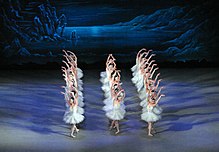
A narrative ballet, also known as classical ballet or story ballet is a form of ballet that has a plot and characters. It is typically a production with full sets and costumes. It was an invention of the eighteenth century.[1]
Most romantic and classical ballets of the 19th century were narrative ballets. Among the most well known are Swan Lake, The Sleeping Beauty, and Cinderella.[2][3] For these and other classic narrative ballets it is common for ballet directors to create their own choreography, while maintaining the plot and music used by the original 19th-century choreographer. Kenneth MacMillan and Frederick Ashton were neoclassical ballet choreographers that created original narrative ballets in the 20th century.[2]
Plots frequently revolve around intense love, expression, fantasy, and tragedy. The most popular classic ballets are based on fairytales and magical myths.
For example, in Swan Lake, the main character Odette is put under a spell by an evil sorcerer that makes her a swan until she turns human at midnight. The spell can only be broken by true love from a man who has not promised his heart to another. She meets a prince and they both fall in love. In the end, the prince was tricked by the evil sorcerer to propose to his daughter. Destined to be a swan forever, Odette plunges herself into the lake from despair. The prince followers her until the river and they are united for eternity in death.[4]

When performing a story ballet, it not only essential that dancers have good technique but that they have the ability to act.[5] This is because in ballet there are no spoken words. It is the responsibility of the dancer to be able to use their movements and facial expressions to the communicate with the audience, or else the plot isn't properly conveyed. The ability to tell a story and how emotion without words is known as "classical mime", which plays an important role in ballet.
Narrative ballets are essential to a ballet company's repertoire, because they tend to generate the highest sales and bring families with children to see the ballet. People enjoy watching an art form where they are transformed into a different world. It's entertaining and exciting. Many newer narrative ballets are adapted from familiar stories or literature because they are recognizable to audiences.[6]
- ^ Cite error: The named reference
presswas invoked but never defined (see the help page). - ^ a b Cite error: The named reference
Kourlaswas invoked but never defined (see the help page). - ^ Cite error: The named reference
guardwas invoked but never defined (see the help page). - ^ https://www.miamicityballet.org/swanlakestory
- ^ https://www.balletdancersguide.com/ballet-stories.html
- ^ Cite error: The named reference
royalwas invoked but never defined (see the help page).
© MMXXIII Rich X Search. We shall prevail. All rights reserved. Rich X Search
